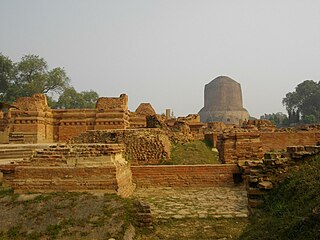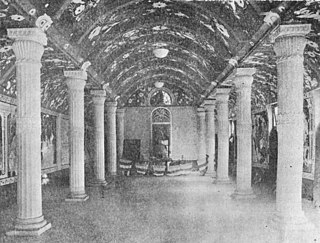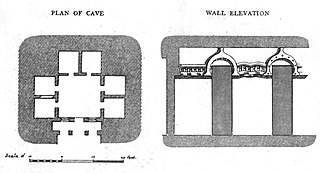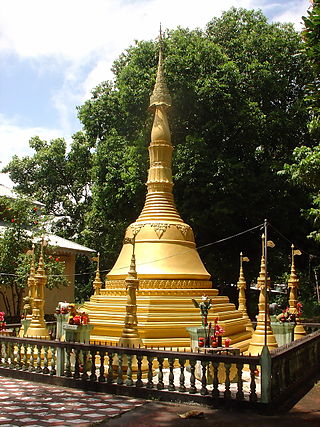
Nalanda was a renowned mahavihara in ancient Magadha, eastern India. Considered by historians to be the world's first residential university and among the greatest centers of learning in the ancient world, it was located near the city of Rajagriha and about 90 kilometres (56 mi) southeast of Pataliputra. Operating from 427 until 1197 CE, Nalanda played a vital role in promoting the patronage of arts and academics during the 5th and 6th century CE, a period that has since been described as the "Golden Age of India" by scholars.

Sarnath is a place located 10 kilometres northeast of Varanasi, near the confluence of the Ganges and the Varuna rivers in Uttar Pradesh, India.

The Maha Bodhi Society is a South Asian Buddhist society presently based in Kolkata, India. Founded by the Sri Lankan Buddhist leader Anagarika Dharmapala and the British journalist and poet Sir Edwin Arnold, its first office was in Bodh Gaya. The organization's efforts began in order to resuscitate Buddhism in India, and to restore the ancient Buddhist shrines at Bodh Gaya, Sarnath and Kushinara. The restoration and revival of the glory and sanctity of Bodh Gaya are also aims of Maha Bodhi Society.

Vihāra generally refers to a Buddhist monastery for Buddhist renunciates, mostly in the Indian subcontinent. The concept is ancient and in early Sanskrit and Pali texts, it meant any arrangement of space or facilities for dwellings. The term evolved into an architectural concept wherein it refers to living quarters for monks with an open shared space or courtyard, particularly in Buddhism. The term is also found in Ajivika, Hindu and Jain monastic literature, usually referring to temporary refuge for wandering monks or nuns during the annual Indian monsoons. In modern Jainism, the monks continue to wander from town to town except during the rainy season (Chaturmas), and the term "vihara" refers to their wanderings.

Buddhism is the third-largest religious affiliation and formed about 0.63% of the population of Bangladesh. It is said that Buddha once in his life came to this region of East Bengal to spread his teachings and he was successful in converting the local people to Buddhism, specially in the Chittagong division and later on Pala empire propagate and patronized Buddhist religion throughout the Bengal territory. About 1 million people in Bangladesh adhere to the Theravada school of Buddhism. Over 65% of the Buddhist population is concentrated in the Chittagong Hill Tracts region, where it is the predominant faith of the Rakhine, Chakma, Marma, Tanchangya, other Jumma people and the Barua. The remaining 35% are Bengali Buddhists. Buddhist communities are present in the urban centers of Bangladesh, particularly Chittagong and Dhaka.
Jagdish Kashyap was a Buddhist monk. He was born on 2 May 1908 in Ranchi, Bengal Presidency, India; he died 28 January 1976. The name Kashyap was given to him at his bhikkhu ordination in 1933.

Abhayagiri Vihāra was a major monastery site of Theravada, Mahayana and Vajrayana Buddhism that was situated in Anuradhapura, Sri Lanka. It is one of the most extensive ruins in the world and one of the most sacred Buddhist pilgrimage cities in the nation. Historically it was a great monastic center as well as a royal capital, with magnificent monasteries rising to many stories, roofed with gilt bronze or tiles of burnt clay glazed in brilliant colours. To the north of the city, encircled by great walls and containing elaborate bathing ponds, carved balustrades and moonstones, stood "Abhayagiri", one of seventeen such religious units in Anuradhapura and the largest of its five major viharas. One of the focal points of the complex is an ancient stupa, the Abhayagiri Dagaba. Surrounding the humped dagaba, Abhayagiri Vihara was a seat of the Northern Monastery, or Uttara Vihara and the original custodian of the Tooth relic in the island.

The Barua, are an ethnic group native to Chittagong Division in Bangladesh, Rakhine State in Myanmar, where they are known as the Maramagyi or Maramagri, and parts of Assam, West Bengal and Tripura in northeast India. According to Arakanese chronology, the Barua Buddhists have lived there for five thousand years. Another derivation of 'Barua' is 'Baru' and 'Arya' meaning great arya. They are commonly identified by their last name, "Barua". Barua is derived from "Baru" meaning "great" and "ua", meaning "noble rulers". In Myanmar, the Barua is classified as one of the seven groups that make up the Rakhine nation. Originally, the Barua title is of Assamese origin.

Buddhism is an ancient Indian religion, which arose in and around the ancient Kingdom of Magadha, and is based on the teachings of Gautama Buddha who was deemed a "Buddha", although Buddhist doctrine holds that there were other Buddhas before him. Buddhism spread outside of Magadha starting in the Buddha's lifetime.

Somapura Mahavihara or Paharpur Buddhist Vihara in Paharpur, Badalgachhi, Naogaon, Bangladesh is among the best known Buddhist viharas or monasteries in the Indian Subcontinent and is one of the most important archaeological sites in the country. It was designated as a UNESCO World Heritage Site in 1985. It is one of the most famous examples of architecture in pre-Islamic Bangladesh. It dates from a period to the nearby Halud Vihara and to the Sitakot Vihara in Nawabganj Upazila of Dinajpur District.
Prajnalok Mahasthavir (1879–1971) was a scholar, writer and orator of Pali and a preacher, educationist and writer of Buddhism.

Shalban Bihar is an archaeological site in Moinamoti, Comilla, Bangladesh. The ruins are in the middle of the Lalmai hills ridge, and these are of a 7th-century Paharpur-style Buddhist Bihar with 115 cells for monks. It operated through the 12th century.
Barua Buddhists come from the small Barua community of Bengali-speaking Theravada Buddhists native to Tripura in north-east India. Barua Buddhist institutes have been established in India and Bangladesh.
Venerable Kripasaran Mahathera was a 19th and 20th century Bengali Buddhist monk and Indian yogi, best known for reviving Buddhism in British India. Kripasaran led a renaissance of Buddhist thought and culture in nineteenth century India.
Mahavihara is the Sanskrit and Pali term for a great vihara and is used to describe a monastic complex of viharas.

Dharmarajika Buddhist Monastery Complex is a Buddhist Monastery (Vihara) that is located in Dhaka, Bangladesh and is the first Buddhist Monastery (Vihara) that was built in Dhaka.

Bangladesh Bauddha Kristi Prachar Sangha is a political and social organization that works for the welfare of the Buddhist community of Bangladesh.
The Indian subcontinent has a long history of education and learning from the era of Indus Valley civilization. Important ancient institutions of learning in ancient India are Takshashila, Kashmir Smast, Nalanda, Valabhi University, Sharada Peeth, Pushpagiri Vihara, Odantapuri University, Vikramashila, Somapura Mahavihara, Bikrampur Vihara, Jagaddala Mahavihara.











